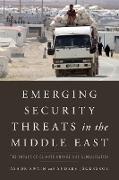Emerging Security Threats in the Middle East
BücherAngebote / Angebote:
The Middle East, particularly its Mashriq region (the region bounded by Iran in the east, Turkey in the north, the Mediterranean in the West, Saudi Arabia in the south, and Egypt, Israel is also included) is a highly securitized part of the world. It contains contentious underlying security liabilities, such as religious radicalism, an ethnic mosaic, widespread terrorism, unfinished state-building projects, and democratic deficits. All these accompany the traditional security problems between states that are acted out through diplomacy (at best) or violence (at worst). Historically, the region gives evidence of limited ability to solve its internal security problems. Increasingly the region and its growing population face a highly complex and fragile security system, where these issues are interacting with a number of extremely critical challenges to peace and stability. The rich deposits of highly attractive natural resources, such as oil and gas, suffer from a strained renewable resource base that includes water and arable land. This leads to water scarcity, desertification, and land degradation. Increasing population, industrialization, and urbanization put more and more demand on the food supply. The climatic variability (with large fluctuations in precipitation between years) also creates challenges. Decreased agricultural output will bring more demand to create new agricultural areas and/or to look for agricultural investments (land and water grabs ) in other parts of the world to meet growing food demand. The already heavy reliance on virtual water (water used to produce mostly foodstuff) will also increase. Energy insecurity is not generally associated with the Middle East, but the countries in the eastern Mediterranean part have been traditionally vulnerable to it as their fossil fuel endowments have been low. However, the finding of major natural gas deposits in that part of the region heralds a new dimension to the existing energy-power structure within the region, creating new challenges as well as opportunities for inter-state relations. Another issue is the large-scale temporary labour migration that has taken place in the region. However, the countries in the region are primarily remittance receiving countries. These remittances represent an important source of income for some of the countries, particularly for Egypt, Lebanon, and Jordan. Aside from economic migrants, the region is also the source or host of a large number of forced migrants, refugees, and internally displaced persons. In addition to long-standing issues involving Palestinian refugees, there is an increasing displacement of population due to on-going violent conflicts in Iraq and Syria. This text analyzes these emerging security challenges in a comprehensive and systematic manner. It draws national and regional security issues into both the global security analysis and human security perspective. It also outlines where the security issues are evolving in this region and possible policy responses.
Folgt in ca. 10 Arbeitstagen

